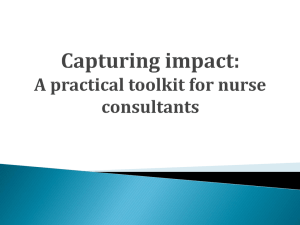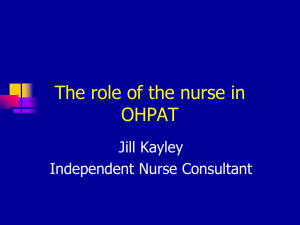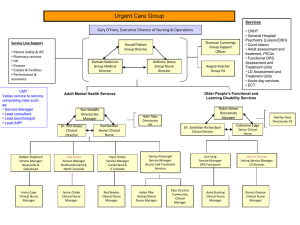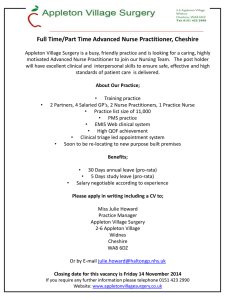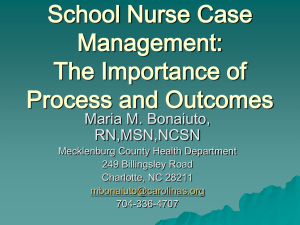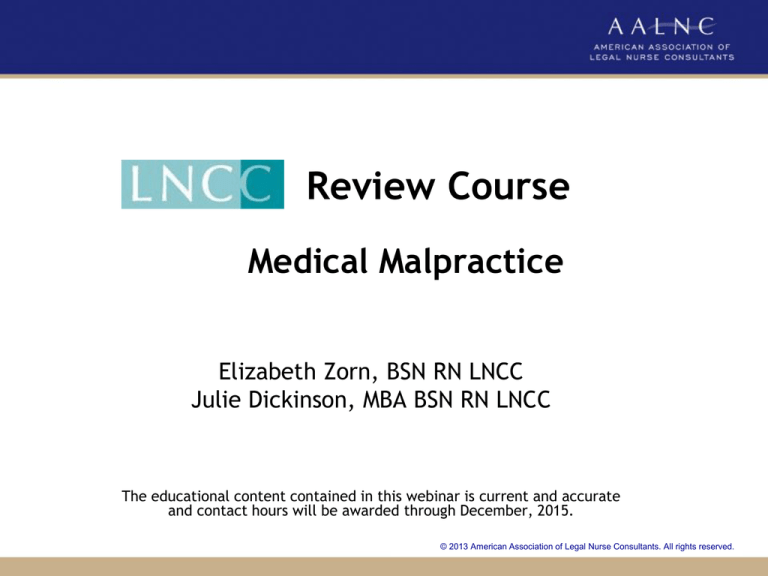
Review Course
Medical Malpractice
Elizabeth Zorn, BSN RN LNCC
Julie Dickinson, MBA BSN RN LNCC
The educational content contained in this webinar is current and accurate
and contact hours will be awarded through December, 2015.
© 2013 American Association of Legal Nurse Consultants. All rights reserved.
Speaker Introductions
Elizabeth Zorn
Julie Dickinson
© 2013 American Association of Legal Nurse Consultants. All rights reserved.
Conflict of Interest Disclosure
Elizabeth Zorn and Julie Dickinson certify that, to the
best of their knowledge, no affiliation or relationship
of a financial nature with a commercial interest
organization has significantly affected their views on
the subject on which they are presenting.
© 2013 American Association of Legal Nurse Consultants. All rights reserved.
Content Areas of the Examination
•
•
•
•
•
•
•
•
•
Medical malpractice (27-31%)
Personal injury (19-23%)
Product liability/toxic tort (10-14%)
Workers' compensation (12-16%)
Risk management (5-9%)
Life care planning (4-7%)
Criminal/forensic (1-4%)
Admin health law/regulatory compliance (4-8%)
Elder law (3-6%)
© 2013 American Association of Legal Nurse Consultants. All rights reserved.
Schedule for Webinar Series
DATE
TOPICS
SPEAKERS
Webinar #1
Medical Malpractice
Elizabeth Zorn
Julie Dickinson
Webinar #2
Personal Injury
Sharon McQuown
Kathy Ferrell
Webinar #3
Test Taking Tips
Sample Questions
Karen Huff
Julie Dickinson
Webinar #4
Workers’ Compensation
Barbara Boschert
Webinar #5
Risk Management
Peg Woodward
Darlene Holt
Webinar #6
Toxic Torts
Rosie Oldham
Catherine Beasley
© 2013 American Association of Legal Nurse Consultants. All rights reserved.
Schedule for Webinar Series
DATE
TOPICS
SPEAKERS
Webinar #7
Product Liability
Rosie Oldham
Catherine Beasley
Webinar #8
Long Term Care Litigation
Karen Huff
Kip Reese, Esq.
Webinar #9
Test Taking Tips
Sample Questions
Karen Huff
Julie Dickinson
Webinar #10
Life Care Planning
Medicare Set-Asides
Patty Costantini
Webinar #11
Criminal / Forensics
Stacey Mitchell
Webinar #12
Licensure Investigations
Regulatory Compliance
Julie Dickinson
Catherine Jordan
© 2013 American Association of Legal Nurse Consultants. All rights reserved.
Objectives for Today’s Webinar
• Analyze the LNC role in screening and investigating
potential medical malpractice claims.
• Outline the role of an LNC during the discovery phase
of a medical malpractice claim.
• Evaluate the role of an LNC in the adjudication of a
medical malpractice claim.
© 2013 American Association of Legal Nurse Consultants. All rights reserved.
Case Study
© 2013 American Association of Legal Nurse Consultants. All rights reserved.
Gentamicin Case Study: Cast of Characters
• Plaintiff: Casey Jones
• 42 years old, married, father of 3 boys
• PMH: IDDM
• Hobbies: family, athletics
• Defendants:
•
•
•
•
Lewis Regan, DPM
Pharmacist
VNS homecare nurses
David Sanchez, MD (PCP)
All names have been changed for confidentiality purposes.
© 2013 American Association of Legal Nurse Consultants. All rights reserved.
Gentamicin Case Study: Chronology of Events
2/96: Mr. Jones began treating with Dr. Regan for diabetic ulcer
on right foot.
2/96 to 8/21/96: Dr. Regan treated the ulcers with debridements
and multiple courses of Cipro. No C&Ss were
obtained during this time.
8/21/96: First culture obtained. Grew gram + bacteria
9/13/96: Second culture obtained. Grew gram + bacteria. Dr.
Regan prescribed Cipro and Dicloxacilin, even though
the sensitivities showed that the bacteria were
resistant to both.
© 2013 American Association of Legal Nurse Consultants. All rights reserved.
Gentamicin Case Study: Chronology of Events
9/24/96: Dr. Regan spoke with Dr. Sanchez. Mr. Jones’ liver and
kidney function tests were WNL. Received the okay to
start Mr. Jones on IV medication.
Infection:
Gentamicin Dosing:
For Mr. Jones:
(91 kg ideal body weight)
Serious
3 mg/kg
273 mg max daily dose
Life-threatening
5 mg/kg
455 mg max daily dose
9/26/96: Dr. Regan prescribed Gentamicin 1g IV QD x 10 days.
© 2013 American Association of Legal Nurse Consultants. All rights reserved.
Gentamicin Case Study: Chronology of Events
9/27/96: Gentamicin begun IV.
9/28/96: VNS recorded a baseline BP of 120/84.
9/30/96: Blood work ordered at insistence of VNS.
• Gentamicin peak level: 20 (6-10)
• Gentamicin trough level: <0.5 (0-2)
10/2/96: Third culture obtained. Grew gram + bacteria.
10/4/96: Tx day #8. Dr. Regan decided to extend tx beyond 10 days.
10/7/96: VNS recorded a BP of 132/88.
© 2013 American Association of Legal Nurse Consultants. All rights reserved.
Gentamicin Case Study: Chronology of Events
10/9/96: Tx day #13. Dr. Regan documented that the Gentamicin tx
would be continuing for a minimum of 8 weeks. VNS and
Dr. Sanchez were aware of this plan.
10/11/96: Dr. Regan orders weekly blood work, beginning on 10/14.
10/14/96: Blood work:
• Gentamicin trough level: 1.6 (0-2)
• BUN: 18 (6-22)
• Serum creatinine: 1.1 (0.4-1.5)
10/15/96: Tx day #19. First documented complaint of dizziness,
though Mr. Jones reported this symptom several times
before. The dizziness was severe and continual.
© 2013 American Association of Legal Nurse Consultants. All rights reserved.
Gentamicin Case Study: Chronology of Events
10/16/96: Dizziness and lightheadedness prevented Mr. Jones from
attending his appointment with Dr. Regan, who noted that
pt “might be coming down with the flu.”
10/18/96: VNS recorded BP of 160/96, n/v, being off-balance,
dizziness. “Using structural supports r/t dizziness.”
10/19-20/96: Mr. Jones paged doctor covering for Dr. Regan.
Reported lightheadedness, nausea, appearing drunk,
falling down. Covering doctor prescribed Antivert.
© 2013 American Association of Legal Nurse Consultants. All rights reserved.
Gentamicin Case Study: Chronology of Events
10/21/96: Mr. Jones reported to Dr. Regan that he was so dizzy, he
couldn’t walk. Dr. Regan stopped Gentamicin for one day
but ordered 500 mg daily starting the next day.
VNS questioned whether these new orders were related to
Gentamicin toxicity.
10/22/96: VNS recorded BP of 170/110 and notified Dr. Regan.
10/23/96: Dr. Regan recommended that Mr. Jones see Dr. Sanchez
and ordered Gentamicin to be restarted “as we cannot
stop it as it has not been long enough.”
Mr. Jones contacted Dr. Sanchez, told him it was difficult
to get to the office due to his symptoms, and was advised
to wait another week to see if his symptoms changed.
© 2013 American Association of Legal Nurse Consultants. All rights reserved.
Gentamicin Case Study: Chronology of Events
10/24/96: VNS felt Gentamicin should be d/c’d but could not reach
Dr. Regan.
10/25/96: Tx day #26.
Dr. Regan returned call to VNS. Agreed not to continue IV
Gentamicin until Mr. Jones saw Dr. Sanchez later this day.
Dr. Regan reiterated that he did not want to stop
Gentamicin.
Dr. Sanchez saw Mr. Jones, d/c’d Gentamicin, ordered
blood work, and requested neurology and vascular surgery
consultations.
© 2013 American Association of Legal Nurse Consultants. All rights reserved.
Gentamicin Case Study: Chronology of Events
10/25/96 (con’t): Dr. Regan saw Mr. Jones and wrote a letter to Dr.
Sanchez expressing concern that the Gentamicin
had been stopped. He explained to Mr. Jones that
“he has only been on the Gentamicin half the
recommended time.”
Blood work:
• Gentamicin trough level: 8.3 (0-2)
• Serum creatinine: 2.9 (0.4-1.5)
11/8/96: Blood work:
• BUN: 70 (6-22)
• Serum creatinine: 7 (0.4-1.5)
Blood pressure remained significantly elevated.
© 2013 American Association of Legal Nurse Consultants. All rights reserved.
Gentamicin Case Study: Chronology of Events
11/15/96: Dr. Sanchez first reviewed the 10/25/96 blood work (21
days later) and advised Mr. Jones to go to ED immediately.
Dx: acute renal failure most likely due to Gentamicin
Blood work:
• BUN: 74 (6-22)
• Serum creatinine: 5.5 (0.4-1.5)
7/30/97:
Mr. Jones sought out a neurology consultation for his
persistent and debilitating balance problems.
Dx: marked bilateral vestibular loss caused by Gentamicin
toxicity.
© 2013 American Association of Legal Nurse Consultants. All rights reserved.
Role of LNC in
Screening and Investigating
a Case for Merit
© 2013 American Association of Legal Nurse Consultants. All rights reserved.
Proper Case Screening Is Essential
• Non-meritorious or even equivocal claims are
vigorously defended by the insurance carriers
• Medical malpractice claims are very time-consuming
and expensive claims
• Plaintiff firms do not make money on nonmeritorious cases
• Firm reputation tied to proper case screening
© 2013 American Association of Legal Nurse Consultants. All rights reserved.
Reasons for Outright Rejection of
Potential Claim - Conflict
Legal conflict (e.g. the firm represented the potential
defendant in a current or prior matter)
Personal conflict (e.g. the potential defendant is a
friend or treating doctor of someone at the firm)
Conflict related to general personal injury practice
(e.g. orthopedic doctors who treat the firm’s auto,
slip & fall clients)
© 2013 American Association of Legal Nurse Consultants. All rights reserved.
Reasons for Outright Rejection of
Potential Claim – SOL issues
Different SOL rules for:
•Medical malpractice
•Wrongful death
•Minor children
•Mentally impaired
•Is there a discovery exception which extends the SOL?
•Is there a continuous treatment exception which
extends the SOL?
© 2013 American Association of Legal Nurse Consultants. All rights reserved.
Reasons for Outright Rejection of
Potential Claim - other
• Wrongful life/birth – no cause of action
• Potential defendant has immunity
• Cannot establish “duty” between the plaintiff and
the potential defendant
© 2013 American Association of Legal Nurse Consultants. All rights reserved.
Cannot Meet Burden of Proof re
Liability or Causation
Elements of negligence claim
•Duty (usually inherent)
•Departure from accepted standards of care
•Damages (sufficient to offset the cost of litigation)
•A causal link between the negligence & the harm
© 2013 American Association of Legal Nurse Consultants. All rights reserved.
Reasons for Outright Rejection of
Potential Claim - Insufficient damages
Cases in which the cost of litigation may exceed the
recovery include those in which the client:
•Sustained only a minor injury
•Has an injury causing no permanent pain or
significant functional limitation
•Suffered only a brief period of pain & suffering or
none at all (plaintiff or decedent)
•Limited financial loss (eg, lost wages)
© 2013 American Association of Legal Nurse Consultants. All rights reserved.
Review - Assessment of Damages
•
•
•
•
•
•
•
•
Physical/emotional pain & suffering
Functional limitations
Economic loss
Loss of enjoyment of life
Loss of consortium ~ spouse
Medical expenses
Out-of-pocket expenses (co-pays, mileage, etc)
Jury verdict searches - prior awards for similar injuries in same
state and especially same venue
• States that have enacted tort reform ~ caps on pain & suffering
awards
© 2013 American Association of Legal Nurse Consultants. All rights reserved.
Economic Factors Impacting Settlement
Negotiations
Are there any liens? (Medicaid, Medicare, workers
compensation, third party health insurance)
Has the client filed for bankruptcy?
Medicare Set-Asides – established from a portion of a
settlement to pay future medical expenses that would
otherwise be covered by Medicare
© 2013 American Association of Legal Nurse Consultants. All rights reserved.
Review - Assessment of Damages
• Does the potential economic recovery (assuming negligence)
offset the cost of litigation?
• Are there significant permanent damages which impact the
quality of the injured person’s life and/or ability to work?
• Is the client already disabled due to a pre-existing condition?
• Did the negligence aggravate a pre-existing condition?
• Is there “gross” negligence or misconduct?
• Are there any liens?
• Is the client involved in or contemplating bankruptcy
proceedings?
© 2013 American Association of Legal Nurse Consultants. All rights reserved.
Types of Cases Which Can be
Problematic for the Plaintiff
• Cosmetic surgery cases
• Certain psychiatric cases
• Cases in which the client has a litany of complaints about
every nurse and doctor who cared for him
• Clients who are non-compliant or otherwise partially
responsible for their injuries
• Clients with short life expectancy not caused by neglience
© 2013 American Association of Legal Nurse Consultants. All rights reserved.
Types of Cases Which Can be
Problematic for the Plaintiff
• Cases in which the primary issue is a “he said (doctor)/she said
(patient)”
• Cases in which the medical records do not support the client’s
version of the facts
• A case already reviewed and rejected by another firm
• Long, complicated courses of treatment with multiple
providers, ending in poor outcome
© 2013 American Association of Legal Nurse Consultants. All rights reserved.
Complication of Surgery Cases
•Clear error (surgical misadventure)
•Most likely not due to error (common risk that can
occur in the absence of negligence and/or no “red
flags” in the record)
•Possibly due to error but may be difficult to prove
this
Must establish likely mechanism of injury and how
proper care would have prevented the injury.
© 2013 American Association of Legal Nurse Consultants. All rights reserved.
Lack of Informed Consent Cause of
Action
• Physicians (and other providers performing
procedures/ordering courses of treatment) have a
duty to discuss with the patient the reasonably
foreseeable risks, benefits and alternatives of a
procedure or course of treatment.
• The plaintiff must prove that the client did not
receive proper informed consent AND that he or she
(or in some states a “reasonable person”) likely
would not have undergone the procedure had they
been properly informed.
© 2013 American Association of Legal Nurse Consultants. All rights reserved.
Lack of Informed Consent - Evidence of
Informed Consent Discussions
• Evidence of the substance of the informed consent
discussion is found in multiple places (consent form,
operative note, hospital progress note, office
record)
• Most plaintiff firms generally do not take cases in
which the ONLY claim is lack of informed consent.
© 2013 American Association of Legal Nurse Consultants. All rights reserved.
Medical Provider Told the Client to Call
a Lawyer
• Most commonly occurs in the setting of a poor and/or
unexpected outcome not resulting from malpractice
• Most medical providers do not understand the proof or other
legal standards related to malpractice claims
• Oftentimes these same providers are unwilling to speak with
the client’s lawyers about the claim
• Occasionally, comments are the result of acrimony between
two providers
• Sometimes the client has misunderstood what the medical
provider told them.
© 2013 American Association of Legal Nurse Consultants. All rights reserved.
Factors Impacting Successful Resolution
of Plaintiff Claims
• Strength of proof issues on liability, causation and
damages
• How a jury will likely perceive both the plaintiff(s)
and the defendant(s)
• Egregious conduct by defendant lessens the
likelihood of trial and increases settlement amount
• Case venue (e.g. urban vs rural settings)
• Cooperation of treating physicians in establishing
causation and damages
© 2013 American Association of Legal Nurse Consultants. All rights reserved.
Factors Impacting Successful Resolution
of Plaintiff Claims
• The Judge - is he/she prepared, knowledgeable
about case facts and in control of the courtroom
• Legal decisions re motions made by counsel
• Quality of expert testimony
• Competence, preparation, organization and work
ethic of managing attorney and his/her team
© 2013 American Association of Legal Nurse Consultants. All rights reserved.
LNC Role In Screening Potential Medical
Malpractice Claims
Is it likely worthwhile to obtain and review the
relevant medical records?
After reviewing the relevant medical records, it is
likely that an expert review on the merits will be
favorable?
© 2013 American Association of Legal Nurse Consultants. All rights reserved.
Researching Standard of Care Issues
• Peer reviewed journal articles
• Authoritative nursing and medical textbooks
• Clinical guidelines promulgated by professional medical and
nursing organizations
• Governmental agencies (FDA, CDC)
• Facility policies & procedures
• The Joint Commission
• Equipment manuals
• Job descriptions
• Drug inserts
© 2013 American Association of Legal Nurse Consultants. All rights reserved.
Researching Standard of Care Issues
• Federal statutes and regulations (such as those
pertaining to nursing homes)
• State statutes (state practice acts for nurses and
physicians)
• State regulations (health department)
• State administrative health codes/regulations
• Case law decisions and administrative rulings
© 2013 American Association of Legal Nurse Consultants. All rights reserved.
Researching Causation Issues
Is it more likely than not that proper care and
treatment would have:
• Prevented death
• Decreased morbidity
• Increased length of disease free survival
• Necessitated less invasive treatment
• Prevented the surgery complication
• Improved the functional outcome
© 2013 American Association of Legal Nurse Consultants. All rights reserved.
Researching Causation Issues
Literature research examples
• Incidence of known complications of a surgical
procedure
• Methods of preventing complications during surgery
• Statistics related to treatment options and chances
of disease free survival at different cancer stages
• Statistics related to odds of success with a
particular treatment
© 2013 American Association of Legal Nurse Consultants. All rights reserved.
Researching Causation Issues
• Did improper care aggravate a stable pre-existing
condition?
• Are any of plaintiff’s alleged complaints solely the
result of a pre-existing condition?
© 2013 American Association of Legal Nurse Consultants. All rights reserved.
Expert review(s)
• Identify appropriate specialties needed for liability
and causation opinions
• Send very organized package of records and letter
setting forth facts and list of questions for expert to
consider.
• Carefully question the expert for the basis for his or
her opinions
© 2013 American Association of Legal Nurse Consultants. All rights reserved.
LNC Role In Screening & Investigating
Potential Medical Malpractice Claims
• What are the strengths of the case?
• What are the weaknesses?
• How is the case likely to be defended?
• Is the potential economic recovery sufficient to
offset the cost of litigation?
© 2013 American Association of Legal Nurse Consultants. All rights reserved.
LNC Role In Screening & Investigating
Potential Medical Malpractice Claims
• Sometimes your most valuable service to an
attorney is to discourage them from taking cases
that are going nowhere!
• That being said, it is very important to take extra
care when evaluating those claims with catastrophic
injuries.
• The “devil is in the details”
© 2013 American Association of Legal Nurse Consultants. All rights reserved.
Intake Information in Gentamycin Case
• Long term gentamycin treatment generally
contraindicated
• Married, working male with two minor children
• Gentamycin induced ototoxicity
• Gentamycin induced nephrotoxicity
• Referred to us by another attorney
© 2013 American Association of Legal Nurse Consultants. All rights reserved.
Additional Information from Initial
Client Interview
• Significant functional limitations from ototoxicity,
impacting ADLs, work and recreational activities
• Neuroophthalmologist told him ototoxicity likely
permanent.
• Insulin dependent diabetic with gentamicin induced
renal problems and new onset high blood pressure
• Told he may need kidney transplant as a result of
kidney damage
© 2013 American Association of Legal Nurse Consultants. All rights reserved.
Initial Medical Literature Research
• Proper care and treatment of diabetic foot ulcers
• Gentamycin therapy – indications, dosage
calculations, duration, monitoring of peak/trough
levels and potential side effects
© 2013 American Association of Legal Nurse Consultants. All rights reserved.
Identification of Health Care Experts
Medical Malpractice cases often require multiple experts!
Gentamicin case
• Podiatry
• Infectious Disease
• Pharmacology
• Nephrology
• Internal Medicine
• Home health care nurse
© 2013 American Association of Legal Nurse Consultants. All rights reserved.
Role of LNC during
Discovery Phase
© 2013 American Association of Legal Nurse Consultants. All rights reserved.
Role of the LNC during Discovery Phase
1. Understand the goal of the discovery phase.
2. Assist with 5 instruments of discovery.
3. Identify sources of potential information.
© 2013 American Association of Legal Nurse Consultants. All rights reserved.
Role of the LNC during Discovery Phase
1. Understand the goal of the discovery phase.
Gather information
Identify key elements
Establish support
Federal Rules of Civil Procedure 26(b)(1):
•
Parties may obtain discovery regarding any nonprivileged
matter that is relevant to any party's claim or defense
© 2013 American Association of Legal Nurse Consultants. All rights reserved.
Role of the LNC during Discovery Phase
1. Understand the goal of the discovery phase.
Jones v. Regan et al:
Relevant:
Not relevant:
Prior medical records
Divorce records
Employment records
Son’s school records
Tax returns
Marital counseling records
© 2013 American Association of Legal Nurse Consultants. All rights reserved.
Role of the LNC during Discovery Phase
2. Assist with five (5) instruments of discovery.
1.
2.
3.
4.
5.
Interrogatories (bills of particulars)
Requests for Production
Depositions
Independent Medical Exams
Requests for Admission
© 2013 American Association of Legal Nurse Consultants. All rights reserved.
Role of the LNC during Discovery Phase
• Discovery Instrument #1: Interrogatories
• From opposing party:
• Act as liaison for the client
• Assist with drafting answers
• Track deadlines
• To opposing party:
• Assist with drafting questions
• Track deadlines
• Review answers and note any objections
© 2013 American Association of Legal Nurse Consultants. All rights reserved.
Role of the LNC during Discovery Phase
• Discovery Instrument #1: Interrogatories
Jones v. Regan et al: Mr. Jones to Dr. Regan
•
•
•
•
•
•
Education and training (related to podiatry)
Licensure (which states, any investigations, any actions)
Board certification
Employment history (as a podiatrist)
All malpractice insurance he carries
Other malpractice claims against him
© 2013 American Association of Legal Nurse Consultants. All rights reserved.
Role of the LNC during Discovery Phase
• Discovery Instrument #1: Interrogatories
Jones v. Regan et al: Dr. Regan to Mr. Jones
•
•
•
•
•
HCPs prior to the alleged incident
HCPs who treated him for the alleged injuries
Ever had symptoms similar to those alleged
Fully recovered from the alleged injuries
Any permanent impairment from the alleged injuries
© 2013 American Association of Legal Nurse Consultants. All rights reserved.
Role of the LNC during Discovery Phase
• Discovery Instrument #2: Requests for Production
• From opposing party:
• Act as liaison for the client
• Assist with compiling requested materials
• Track deadlines
• To opposing party:
•
•
•
•
•
Assist with drafting requests
Track deadlines
Review and analyze documents produced and note any objections
Track items “to be produced”
Work with attorney to determine if supplemental requests are needed
© 2013 American Association of Legal Nurse Consultants. All rights reserved.
Role of the LNC during Discovery Phase
• Discovery Instrument #2: Requests for Production
Jones v. Regan et al: Mr. Jones to VNA
• Complete medical record of Mr. Jones
• Complete billing record of Mr. Jones
• Policies and procedures related to:
• Administration of IV antibiotics
• Physician notification of abnormal VS, blood work, exam findings
© 2013 American Association of Legal Nurse Consultants. All rights reserved.
Role of the LNC during Discovery Phase
• Discovery Instrument #2: Requests for Production
Jones v. Regan et al: Dr. Regan to Mr. Jones
• Complete records from HCPs prior to the alleged incident
• Complete records from HCPs who treated him for the
alleged injuries
• Any photographs or videotapes pertaining to alleged
incident
© 2013 American Association of Legal Nurse Consultants. All rights reserved.
Role of the LNC during Discovery Phase
• Discovery Instrument #3: Depositions
• Same-side Deponent:
• Assist with witness preparation
• Assist with any questions
• Opposing-side Deponent:
• Assist with preparing questions
• Either Deponent:
• Attend deposition to suggest follow up questions or a
particular line of questioning
• Assess deponent as a witness
• Prepare summary of deposition
© 2013 American Association of Legal Nurse Consultants. All rights reserved.
Role of the LNC during Discovery Phase
• Discovery Instrument #3: Depositions
Jones v. Regan et al: depo prep of Mr. Jones
• Understand the question.
• Answer only what was asked.
• Tell the truth. You’re under oath.
• It is okay to say “I don’t remember” or “I don’t know.”
• Be careful about assumptions and words such as “never”
and “always.”
• Be cooperative. Don’t argue.
• Correct any mistakes.
© 2013 American Association of Legal Nurse Consultants. All rights reserved.
Role of the LNC during Discovery Phase
• Discovery Instrument #3: Depositions
Jones v. Regan et al: Dr. Regan
•
•
•
•
His experience and training in treating foot ulcers
His experience and training in prescribing antibiotics
Purpose of C&S and its role in the prescription of ATBs
At the time in question, his understanding of:
• Gentamicin dosing and duration of tx
• The s/s of ototoxicity and nephrotoxicity
• Risk of nephrotoxicity in diabetic patients
© 2013 American Association of Legal Nurse Consultants. All rights reserved.
Role of the LNC during Discovery Phase
• Discovery Instrument #3: Depositions
Jones v. Regan et al: Mr. Jones
•
•
•
•
•
•
•
•
Compliance with diabetic medication regimen
Frequency of foot ulcers
Compliance with foot care regimen
Compliance with prior antibiotic medication regimens
Compliance with administration of IV Gentamicin
Limitations from foot ulcers on participation in sports
Prior hearing or balance problems
Prior kidney or blood pressure problems
© 2013 American Association of Legal Nurse Consultants. All rights reserved.
Role of the LNC during Discovery Phase
• Discovery Instrument #4: Independent medical exams
• Defense:
• Locate and act as liaison for practitioner to
examine plaintiff
• Work with both counsel to arrange IME
• Plaintiff:
• Attend and document IME
• Submit report detailing the IME
© 2013 American Association of Legal Nurse Consultants. All rights reserved.
Role of the LNC during Discovery Phase
• Discovery Instrument #5: Requests for Admission
• Assist with drafting requests
• Track deadlines
© 2013 American Association of Legal Nurse Consultants. All rights reserved.
Role of the LNC during Discovery Phase
• Discovery Instrument #5: Requests for Admission
Jones v. Regan et al: Mr. Jones to Dr. Regan
• Do you admit or deny that dizziness, unsteady gait, nausea, and
vomiting are signs and symptoms of ototoxicity?
• Do you admit or deny that Mr. Jones had signs and symptoms of
ototoxicity on or about October 19, 1996?
© 2013 American Association of Legal Nurse Consultants. All rights reserved.
Role of the LNC during Discovery Phase
3. Identify sources of potential information that will
likely support and give credence to your attorneyclient’s legal position.
• Interrogatory responses
• Requests for Production (medical records and other)
• Deposition
© 2013 American Association of Legal Nurse Consultants. All rights reserved.
Role of the LNC during Discovery Phase
3. Identify sources of potential information.
Jones v. Regan et al: Mr. Jones’ deposition
Page 56
3
4
at that time. In 1995, I was seen at Community
Hospital for some problem with my foot.
© 2013 American Association of Legal Nurse Consultants. All rights reserved.
Role of LNC in the
Adjudication of a Claim
© 2013 American Association of Legal Nurse Consultants. All rights reserved.
Role of LNC in the Adjudication of a Claim
• Settlement
• Alternative Dispute Resolution
• Trial
© 2013 American Association of Legal Nurse Consultants. All rights reserved.
Role of LNC in the Adjudication of a Claim
• Settlement
• Assist with preparation of settlement brochure / demand package
© 2013 American Association of Legal Nurse Consultants. All rights reserved.
Role of LNC in the Adjudication of a Claim
• Settlement: Jones v. Regan et al
Demand Package:
• Opening:
• We are writing to propose settlement negotiations.
• It is in everyone’s best interest to resolve this claim early and save
considerable resources.
• We outline below our understanding of the facts and departures.
• Enclosures:
• Medical records
• Background information on Gentamicin
© 2013 American Association of Legal Nurse Consultants. All rights reserved.
Role of LNC in the Adjudication of a Claim
• Settlement: Jones v. Regan et al
Demand Package:
• Standards of Care related to Gentamicin:
1. Gentamicin is used only when clearly indicated and safer alternatives
are not available.
2. Proper dosing is critical.
3. Protracted courses of Gentamicin must be avoided whenever there are
alternatives.
4. Patients who must be on high doses or prolonged courses of Gentamicin
require close clinical observation and monitoring of renal, auditory and
vestibular (balance) function.
5. If the patient develops signs or symptoms of toxicity, Gentamicin must
be stopped immediately.
© 2013 American Association of Legal Nurse Consultants. All rights reserved.
Role of LNC in the Adjudication of a Claim
• Settlement: Jones v. Regan et al
Demand Package:
• Case Facts
• Liability:
1. Gentamicin was the wrong drug.
2. Both the 1,000 mg dose and 26 day course were medically
unjustifiable and extremely dangerous.
3. Monitoring was grossly deficient.
4. Persistent signs and symptoms of developing Gentamicin toxicity
were either not recognized or ignored.
5. Lack of informed consent
• Injuries
• Conclusion
© 2013 American Association of Legal Nurse Consultants. All rights reserved.
Role of LNC in the Adjudication of a Claim
• Alternative Dispute Resolution (mediation, arbitration)
• Assist with drafting mediation position statement
• Identify and prepare exhibits
• Attend ADR with attorney
© 2013 American Association of Legal Nurse Consultants. All rights reserved.
Role of LNC in the Adjudication of a Claim
• Alternative Dispute Resolution (mediation, arbitration)
Jones v. Regan et al: Identify & prepare exhibits for Mr. Jones
Gentamicin trough
Gentamicin peak
9
8
20
7
15
6
5
Gentamicin Trough
4
Low normal
3
High normal
2
Low normal
10
High normal
Gentamicin Peak
5
0
1
0
30-Sep
30-Sep
7-Oct
14-Oct
21-Oct
© 2013 American Association of Legal Nurse Consultants. All rights reserved.
Role of LNC in the Adjudication of a Claim
• Alternative Dispute Resolution (mediation, arbitration)
Jones v. Regan et al: Identify & prepare exhibits for Mr. Jones
BUN
Creatinine
80
8
70
7
60
6
50
BUN
40
Low normal
30
High normal
5
2
10
1
21-Oct
28-Oct
4-Nov
11-Nov
low normal
3
20
0
14-Oct
Creatinine
4
0
14-Oct
high normal
21-Oct
28-Oct
4-Nov
11-Nov
© 2013 American Association of Legal Nurse Consultants. All rights reserved.
Role of LNC in the Adjudication of a Claim
• Trial (pre)
• Participate in pretrial discussions with attorney regarding
motions in limine
• Identify and prepare exhibits
• Identify what exhibits may help the jury to understand the
complex concepts that will be presented
• Prepare the exhibits
• Have witnesses approve the exhibits they will be using
during their testimony to demonstrate a point
© 2013 American Association of Legal Nurse Consultants. All rights reserved.
Role of LNC in the Adjudication of a Claim
• Trial (pre)
Jones v. Regan et al:
• Motions in Limine:
• Ex: If Dr. Regan had a prior action on his license, his attorney
may try to prevent that from coming before the jury.
• Identify and prepare exhibits
© 2013 American Association of Legal Nurse Consultants. All rights reserved.
Role of LNC in the Adjudication of a Claim
• Trial (pre)
• Aid in the preparation of witnesses
• Explain what will take place at trial
• Ensure witness has a clear understanding of the theory of
the case
• Liaison for witnesses
• Work with attorney and witness to schedule the witness for
trial testimony
• Maintain contact with witness as needed throughout trial
© 2013 American Association of Legal Nurse Consultants. All rights reserved.
Role of LNC in the Adjudication of a Claim
• Trial (during)
• Be familiar with the applicable state or federal requirements
pertaining to medical expert testimony
Legal Rulings on Medical Expert Testimony
• Frye v. United States (1923)
• Daubert v. Merrell Dow Pharmaceuticals, Inc. (1993)
FRE 702: Testimony by Expert Witnesses
FRE 802: Hearsay Rule
© 2013 American Association of Legal Nurse Consultants. All rights reserved.
Role of LNC in the Adjudication of a Claim
• Trial (during)
• Be prepared to perform a wide variety of tasks
• Assist with the presentation of evidence
• Keep track of which exhibits are offered into evidence,
objected to being admitted, or withdrawn.
• Take detailed and accurate notes of testimony and note
additional areas for examination by the attorney
• Analyze witness testimony and identify any inaccuracies
© 2013 American Association of Legal Nurse Consultants. All rights reserved.
Role of LNC in the Adjudication of a Claim
• Trial (during)
Jones v. Regan et al: Identify inaccuracies in testimony
• Defense LNC:
• Mr. Jones at trial: “I never rescheduled any appointments with Dr. Regan.”
• Mr. Jones at depo: “I can’t say that I didn’t reschedule appointments…”
• Plaintiff LNC:
• Dr. Regan at trial: “Ototoxicity is a SE of Gentamicin, and I therefore
instructed Mr. Jones to notify me if he developed nausea or vomiting.”
• Dr. Regan at depo: “I don’t give my patients specific side effects, but I tell
them to call if there is anything that they’re concerned about.
© 2013 American Association of Legal Nurse Consultants. All rights reserved.
Role of LNC in the Adjudication of a Claim
• Trial (post)
• Assist with preparing bill of costs (if applicable)
• Assist with post-trial juror interviews
© 2013 American Association of Legal Nurse Consultants. All rights reserved.
Role of LNC in the Adjudication of a Claim
• Trial (post)
Jones v. Regan et al: Juror interviews
• What was the most convincing piece of evidence in your opinion?
• What did you think of Atty. Smith’s style of questioning ?
• How credible did you find Dr. Regan and why?
© 2013 American Association of Legal Nurse Consultants. All rights reserved.
Sample Questions from
LNCC Practice Exam
®
© 2013 American Association of Legal Nurse Consultants. All rights reserved.
Sample Questions: Medical Malpractice
In selecting a physician expert witness, an LNC will
look for a physician that
a. Only testifies for plaintiffs
b. Holds a law degree
c. Is board certified in the contested area of clinical
practice
d. Derives a substantial part of his income from
testifying
© 2013 American Association of Legal Nurse Consultants. All rights reserved.
Rationale:
Professional credentials, such as certification in the
specialty, reflect the highest level of expertise and
knowledge of the appropriate standard of care.
Hazelwood, M. L. (2010). Locating and working with expert
witnesses. In A. Peterson & L. Kopishke (Eds), Legal nurse
consulting: Principles (435). Boca Raton, FL: CRC Press.
© 2013 American Association of Legal Nurse Consultants. All rights reserved.
Rationale:
a. Only testifies for plaintiffs: If a plaintiff hires an expert
who only testifies for plaintiffs, defense counsel will argue
that this expert’s opinions are not objective, but biased
towards plaintiffs.
b. Holds a law degree: Clinical experts are hired only based
upon their clinical credentials and experience. Legal
credentials are not only unnecessary, but can be
problematic if opposing counsel tries to argue that the
expert’s opinions are based upon knowledge of legal
strategy instead of being purely clinical.
d.
Derives a substantial part of his income from testifying:
Experts who derive a substantial portion of their income
from doing expert work are portrayed as professional
witnesses, also known as hired guns or experts who will say
anything for a fee from the attorney hiring them.
© 2013 American Association of Legal Nurse Consultants. All rights reserved.
Sample Questions: Medical Malpractice
To preserve the statute of limitations, the plaintiff
LNC may assist the attorney in preparing a
a. Complaint
b. Motion for protective order
c. Request for admissions
d. Request for production
© 2013 American Association of Legal Nurse Consultants. All rights reserved.
Rationale:
Statute of Limitations: specific period of time
between an occurrence and the filing of the lawsuit
Complaint: the original or initial pleading by which
an action is commenced
Sisko, N. (2010). Glossary. In A. Peterson & L. Kopishke (Eds),
Legal nurse consulting: Principles (659, 678). Boca Raton,
FL: CRC Press.
© 2013 American Association of Legal Nurse Consultants. All rights reserved.
Rationale:
b.
Motion for protective order: A motion for protect
order is filed during discovery when seeking to
preclude discovery by opposing counsel of certain
documents or information.
c.
Request for admissions: Request for admissions are
written statements of fact concerning the case
which are submitted to an adverse party and which
that party is required to admit or deny.
d.
Request for production: Request for production is a
formal written request compelling a party to
produce documents or other items subject to
discovery rules.
© 2013 American Association of Legal Nurse Consultants. All rights reserved.
Sample Questions: Medical Malpractice
Forty-four-year-old Charlene Cook underwent a
total abdominal hysterectomy. Two days after
hospital discharge, she called the surgeon to report
her wound had separated. She was seen and home
health wound care was ordered. Several days later
the home health nurse noted increased drainage and
a slight elevation in Ms. Cook’s temperature. Oral
antibiotics were prescribed.
© 2013 American Association of Legal Nurse Consultants. All rights reserved.
Sample Questions: Medical Malpractice
Her symptoms persisted and three days later the
drainage had a foul odor. The nurse noted a small
piece of blue material extruding from the wound.
Ms. Cook was admitted to the hospital and a sponge
was surgically removed. Ms. Cook was able to return
to work eight-weeks after her initial surgery. Ms.
Cook’s attorney filed suit with claims for damages
including lost wages, pain and suffering and medical
costs. A complaint is filed naming the surgeon,
hospital and home health agency as defendants.
© 2013 American Association of Legal Nurse Consultants. All rights reserved.
Sample Questions: Medical Malpractice
In interviewing the home health nurse, it is
essential for the defense LNC to determine if
a. Records accurately reflect the time and content
of all calls to the surgeon’s office
b. Records were ever left in the plaintiff’s house,
unattended
c. Nurses were present in the plaintiff’s house all
the hours they documented
d. The home health nurses spoke to anyone else
about the case
© 2013 American Association of Legal Nurse Consultants. All rights reserved.
Rationale:
“In preparation for the initial interview with a health
care provider defendant (HCPD), the LNC should
prepare a list of questions covering areas such as:
• Clarification of the HCPD’s charting”
Conklin, M. R. & Fox, K. S. (2010). Communication with clients in
the medical malpractice arena. In A. Peterson & L. Kopishke
(Eds), Legal nurse consulting: Principles (234). Boca Raton,
FL: CRC Press.
© 2013 American Association of Legal Nurse Consultants. All rights reserved.
Rationale:
b. Records were ever left in the plaintiff’s house,
unattended
c. Nurses were present in the plaintiff’s house all
the hours they documented
d. The home health nurses spoke to anyone else
about the case
None of these answer options likely have any
bearing on the liability of the visiting nurse or the
surgeon.
© 2013 American Association of Legal Nurse Consultants. All rights reserved.
Sample Questions: Medical Malpractice
The defense LNC understands the hospital’s liability
is not disputed because the case involves
a. res ipsa loquitor
b. Delayed onset of symptoms
c. Antibiotics obtained from their pharmacy
d. Several defendants
© 2013 American Association of Legal Nurse Consultants. All rights reserved.
Rationale:
Res ipsa loquitor: the thing speaks for itself; the
mere facts provide information supporting negligence
Sisko, N. (2010). Glossary. In A. Peterson & L. Kopishke (Eds),
Legal nurse consulting: Principles (677). Boca Raton, FL: CRC
Press.
© 2013 American Association of Legal Nurse Consultants. All rights reserved.
Rationale:
b. Delayed onset of symptoms
c. Antibiotics obtained from their pharmacy
d. Several defendants
None of these answer options would impose
automatic liability on the hospital.
© 2013 American Association of Legal Nurse Consultants. All rights reserved.
Sample Questions: Medical Malpractice
The plaintiff LNC will expect Ms. Cook’s settlement to be
a. Significant because the defendants accepted liability
b. Significant because the case involves several
defendants
c. Relatively modest because she was beyond childbearing years
d. Relatively modest because there was little residual
damage
© 2013 American Association of Legal Nurse Consultants. All rights reserved.
Rationale:
“The monetary value of any claim is based on the
perceived value of the plaintiff’s injuries. . . Permanency
of an injury and impairment in ability to work or engage
in activities of daily living must all be considered in
determining damages.”
Miller, P. Z. (2010). Elements of triage: Effective case screening of
medical malpractice claims. In A. Peterson & L. Kopishke (Eds),
Legal nurse consulting: Principles (110). Boca Raton, FL: CRC
Press.
© 2013 American Association of Legal Nurse Consultants. All rights reserved.
Rationale:
a.
Significant because the defendants accepted liability:
Settlement amounts are based primarily on an analysis of the
harm caused by the negligence, regardless of whether or not
the defendant disputes liability.
b.
Significant because the case involves several defendants: When
there are multiple defendants, this does not increase the
settlement award given to the plaintiff. Instead, the total
amount of the award is divided up among the defendants,
usually based upon an agreement among the defendants as to
their respective liability.
c.
Relatively modest because she was beyond child-bearing years:
The fact that she was beyond child bearing is of no importance
in assessing damages in this case.
© 2013 American Association of Legal Nurse Consultants. All rights reserved.
Sample Questions: Medical Malpractice
Alan Judd, a 58-year-old male, had an aortic valve
replacement with repair of an ascending aortic
aneurysm. Mr. Judd experienced post-operative
hemorrhaging and an emergency surgery was
performed. He received 17 units of blood products.
Eight months later, Mr. Judd was diagnosed with
hepatitis C. He believed the hepatitis C was
contracted from the blood transfusion so he
contacted an attorney.
© 2013 American Association of Legal Nurse Consultants. All rights reserved.
Sample Questions: Medical Malpractice
After identifying all blood product unit numbers, the
plaintiff LNC should determine
a. Risk factors for which blood donors were screened
b. Where the blood was donated and collected
c. The identity of the nurses who administered the blood
d. State requirements for blood unit testing
© 2013 American Association of Legal Nurse Consultants. All rights reserved.
Rationale:
“The LNC identifies all records needed for the
managing attorney and medical/nursing expert (s)
to render an opinion about the merits of the case.”
Zorn, E. & Lanz, M. (2010). Legal nurse consultant practice
within a law firm. In A. Peterson & L. Kopishke (Eds), Legal
nurse consulting: Practices (78-79). Boca Raton, FL: CRC
Press.
© 2013 American Association of Legal Nurse Consultants. All rights reserved.
Rationale:
a. Risk factors for which blood donors were screened
c. The identity of the nurses who administered the blood
d. State requirements for blood unit testing
Prior to identifying the relevant state requirements for
blood unit testing and investigating the risk factors for
which blood donors are screened at a particular facility,
the first step in the investigation would involve
identifying where the blood was donated and collected.
The identity of the nurse who administered the blood is
not likely relevant to the initial investigation.
© 2013 American Association of Legal Nurse Consultants. All rights reserved.
Sample Questions: Medical Malpractice
The medical director of the lab at the time of the
incident is now retired. To obtain the medical
director’s testimony regarding the incident, the
plaintiff LNC will assist in preparing a
a. Request for sub rosa
b. Motion in limine
c. Writ of certiorari
d. Subpoena duces tecum
© 2013 American Association of Legal Nurse Consultants. All rights reserved.
Rationale:
Subpoena duces tecum: A process by which the court
commands a witness to produce at trial some
document or paper in his possession or control that is
pertinent to the issues of a pending controversy
Sisko, N. (2010). Glossary. In A. Peterson & L. Kopishke (Eds),
Legal nurse consulting: Principles (678). Boca Raton, FL: CRC
Press.
© 2013 American Association of Legal Nurse Consultants. All rights reserved.
Rationale:
a. Request for sub rosa: Latin for “under the rose”; A
technique of investigation that uses videotape surveillance
of a plaintiff or claimant; carried out by a private
investigator for the defense.
b. Motion in limine: A pretrial motion that requests the court to
issue an order which prevents an opposing party from
introducing or referring to potentially irrelevant, prejudicial
or otherwise inadmissible evidence until the court has finally
ruled on its admissibility.
c. Writ of certiorari: A decision by the Supreme Court to hear
an appeal from a lower court.
© 2013 American Association of Legal Nurse Consultants. All rights reserved.
References
Cartwright-Vanzant, R. (2011). Standards of care. Journal of Legal Nurse Consulting,
22(1), 14-18.
Fitzgerald, W.B. (1992). Checklist for the witness. For the Defense, Retreived from
http://law.uark.edu/documents/Bailey_Trial_Notebook_%28Trial_Advocacy%29.pdf
Peterson, A., & Kopishke, L. (Eds.). (2010). Legal nurse consulting: Principles (3rd ed.).
Boca Raton, FL: CRC Press.
© 2013 American Association of Legal Nurse Consultants. All rights reserved.
QUESTIONS???
• Faculty
• Elizabeth Zorn – elzorn@faraci.com
• Julie Dickinson – julie.dickinson@aya.yale.edu
• For additional questions
• Website: www.lnccertified.org or www.aalnc.org/lncc
• Email address for LNCC Certification inquiries:
info@lnccertified.org
© 2013 American Association of Legal Nurse Consultants. All rights reserved.

